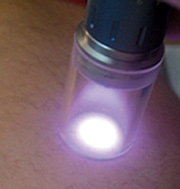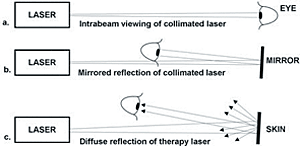Class IV therapy lasers are being used by a growing number of chiropractors. High-powered therapy lasers have the ability to deliver a therapeutic dosage in less time, but the potential risk for injury is greater.
All therapy procedures carry with them an element of risk, either through carelessness or by accident. Periosteal burns and cavitation are possible with ultrasound and surface burns can result from improperly used hot packs or electric muscle stimulation. Safety procedures should be in place for all therapies used in a chiropractic office.
Laser safety guidelines must be followed primarily due to the risk of eye injury. Direct exposure or reflected laser light can be focused by the lens, causing damage to the retina and resulting in scotoma, a blind spot in the fovea. Light incident on the eye is magnified more than 100,000 times by the lens.
 Figure 1: Visible light ranges from 400-700 nanometers (nm). Ultraviolet wavelengths are shorter than 400 nm, and infrared wavelengths are longer than 700 nm.
Visible light has wavelengths between 400 and 700 nm (Figure 1), and therapy lasers use wavelengths between 635 and 980 nm. Class IV therapy lasers use wavelengths in the near infrared, so they are invisible to the human eye but can be visualized using a digital camera (Figure 2). Wavelengths from 400 to 1,400 nm are focused by the cornea and lens and absorbed by the retina.
Figure 1: Visible light ranges from 400-700 nanometers (nm). Ultraviolet wavelengths are shorter than 400 nm, and infrared wavelengths are longer than 700 nm.
Visible light has wavelengths between 400 and 700 nm (Figure 1), and therapy lasers use wavelengths between 635 and 980 nm. Class IV therapy lasers use wavelengths in the near infrared, so they are invisible to the human eye but can be visualized using a digital camera (Figure 2). Wavelengths from 400 to 1,400 nm are focused by the cornea and lens and absorbed by the retina.
 Figure 2: Class IV lasers use infrared wavelengths, which are invisible, but can be photographed with a digital camera.
Power is the rate of energy delivery and is measured in watts, equivalent to a joule per second. Class IV lasers have power output greater than 500 milliwatts (mw), and the highest-powered FDA-cleared therapy laser has a maximum power of 12 watts (12,000 mw). Just as with household light bulbs, a higher wattage indicates brighter light.
Figure 2: Class IV lasers use infrared wavelengths, which are invisible, but can be photographed with a digital camera.
Power is the rate of energy delivery and is measured in watts, equivalent to a joule per second. Class IV lasers have power output greater than 500 milliwatts (mw), and the highest-powered FDA-cleared therapy laser has a maximum power of 12 watts (12,000 mw). Just as with household light bulbs, a higher wattage indicates brighter light.
The blink reflex is "lid closure associated with the involuntary upward movement of the eye, triggered by an external event"such as a bright flash of light.1 The aversion response is "movement of the eye, eyelid, or the head to avoid an exposure to a bright light" and can occur in one-fourth of a second, which includes the blink reflex time.2 Since Class IV therapy lasers use invisible infrared wavelengths, they do not trigger the blink reflex or aversion response. This is a crucial point to emphasize with those new to high-powered therapy lasers.
The maximum permissible exposure (MPE) is "the level of laser radiation to which a person may be exposed without hazardous effects ... in the eye or skin."3 In the MPE calculation, the worst-case scenario is assumed, in which the eye lens focuses the light into the smallest possible spot size on the retina for the particular wavelength and the pupil is fully open. Exposure to direct or reflected laser light above the MPE can result in injury.
The nominal hazard zone (NHZ) is "the space within which the level of the direct, reflected or scattered radiation during normal operation exceeds the applicable MPE."4 The NHZ for most class IV therapy lasers is 21 feet. This means that all people within a radius of 21 feet must be wearing appropriate eye protection when the laser is in operation.
Eye protection must be supplied by the laser company. Normal sunglasses do not provide adequate protection. Laser safety eyewear is marked with the optical density (OD); a measure of the ability to block out specific wavelengths of laser light to a safe level below the MPE.5 Laser manufacturers and distributors should provide information on the MPE, NHZ and OD in the safety manual supplied with the laser equipment.
The beam from a surgical laser is tightly collimated, whereas the beam from a high-powered therapy laser is divergent. Class IV therapy lasers use diodes as the lasing material, which consists of at least two layers of a semiconductor material sandwiched together. Unlike other types of lasers (gas, solid, metal vapor or dye), diode lasers have beams with a large divergence.6
 Figure 3: Conditions of ocular exposure to direct or reflected laser beams.6
When a collimated beam bounces off a highly reflective surface (Figure 3b), the reflected beam maintains a high energy density and the possibility to cause eye damage is very high. The beam from a high-powered therapy laser is normally reflecting off a rough surface of the skin (Figure 3c), so the reflected beams have a much lower energy density and carry a significantly reduced risk of eye injury. The mirrored reflection of a collimated laser can cause immediate blindness, whereas the diffuse reflection of a therapy laser is comparable to looking at the sun through a layer of thin clouds (Figure 2).
Figure 3: Conditions of ocular exposure to direct or reflected laser beams.6
When a collimated beam bounces off a highly reflective surface (Figure 3b), the reflected beam maintains a high energy density and the possibility to cause eye damage is very high. The beam from a high-powered therapy laser is normally reflecting off a rough surface of the skin (Figure 3c), so the reflected beams have a much lower energy density and carry a significantly reduced risk of eye injury. The mirrored reflection of a collimated laser can cause immediate blindness, whereas the diffuse reflection of a therapy laser is comparable to looking at the sun through a layer of thin clouds (Figure 2).
To summarize, an increasing number of chiropractors are discovering Class IV therapy lasers to be an effective modality for pain management and injury healing. They have the ability to deliver a therapeutic dosage in less time, but also carry an increased risk of eye injury and must be used in a closed room with everyone wearing laser-specific eye protection.
References
- American National Standard Institute (ANSI). Safe Use of Lasers in Health Care Facilities. ANSI Z136.3-2005.
- Ibid.
- Ibid.
- Ibid.
- Ibid.
- Rockwell RJ Jr., et al. Medical Users Guide for Laser Safety. Rockwell Industries, 2000.
Part 1 of this article series appeared in the Jan. 1, 2009 issue of DC.
Dr. Phil Harrington is a certified medical laser safety officer and serves on the subcommittee reviewing the ANSI Standards for Safe Use of Lasers in Health Care Facilities. He is a 1996 Palmer graduate and also holds a bachelor's degree in physics. He is the medical director, clinical manager and laser safety officer for Summus Medical Laser (www.summuslaser.com).




